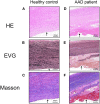Angiopoietin 2 as a Novel Potential Biomarker for Acute Aortic Dissection
- PMID: 35004874
- PMCID: PMC8733161
- DOI: 10.3389/fcvm.2021.743519
Angiopoietin 2 as a Novel Potential Biomarker for Acute Aortic Dissection
Abstract
Biomarker-assisted diagnosis of acute aortic dissection (AAD) is important for initiation of treatment and improved survival. However, identification of biomarkers for AAD in blood is a challenging task. The present study aims to find the potential AAD biomarkers using a transcriptomic strategy. Arrays based genome-wide gene expression profiling were performed using ascending aortic tissues which were collected from AAD patients and healthy donors. The differentially expressed genes were validated using quantitative reverse transcriptase PCR (qRT-PCR) and western blot. The plasma levels of a potential biomarker, angiopoietin 2 (ANGPT2) were determined in case-control cohort (77 AAD patients and 82 healthy controls) by enzyme linked immunosorbent assay. Receiver operating characteristic curve (ROC) was used to evaluate the diagnostic power of ANGPT2 for AAD. Transcriptome data demonstrated that a total of 18 genes were significantly up-regulated and 28 genes were significantly down-regulated among AAD tissues (foldchange>3.0, p < 0.01). By bioinformatic analysis, we identified ANGPT2 as a candidate biomarker for blood-based detection of AAD. The qRT-PCR and protein expression demonstrated that ANGPT2 increased 2.4- and 4.2 folds, respectively in aortic tissue of AAD patients. Immunohistochemical staining demonstrated that ANGPT2 was markedly increased in intima of the aortic wall in AAD. Furthermore, ANGPT2 was significantly elevated in AAD patients as compared with controls (median 1625 vs. 383 pg/ml, p < 1E-6). ROC curve analysis showed that ANGPT2 was highly predictive of a diagnosis of type A AAD (area under curve 0.93, p < 1E-6). Sensitivity and specificity were 81 and 90%, respectively at the cutoff value of 833 pg/ml. In conclusion, ANGPT2 could be a promising biomarker for diagnosis of AAD; however, more studies are still needed to verify its specificity in diagnosing of AAD.
Keywords: acute aortic dissection; angiopoietin 2; biomarker; diagnosis; transcriptome.
Copyright © 2021 Huang, Tian, Chen, Zhang, Su, Lu, Yang, Hui, Wang and Fan.
Conflict of interest statement
The authors declare that the research was conducted in the absence of any commercial or financial relationships that could be construed as a potential conflict of interest.
Figures






Similar articles
-
Applying multi-omics techniques to the discovery of biomarkers for acute aortic dissection.Front Cardiovasc Med. 2022 Dec 15;9:961991. doi: 10.3389/fcvm.2022.961991. eCollection 2022. Front Cardiovasc Med. 2022. PMID: 36588568 Free PMC article. Review.
-
Differential expression of microRNAs in aortic tissue and plasma in patients with acute aortic dissection.J Geriatr Cardiol. 2015 Nov;12(6):655-61. doi: 10.11909/j.issn.1671-5411.2015.06.013. J Geriatr Cardiol. 2015. PMID: 26788043 Free PMC article.
-
The diagnostic and prognostic value of SAA1 as a novel biomarker for acute aortic dissection.J Proteomics. 2023 Aug 30;286:104958. doi: 10.1016/j.jprot.2023.104958. Epub 2023 Jul 6. J Proteomics. 2023. PMID: 37422110
-
The diagnostic value of microRNA-4787-5p and microRNA-4306 in patients with acute aortic dissection.Am J Transl Res. 2017 Nov 15;9(11):5138-5149. eCollection 2017. Am J Transl Res. 2017. PMID: 29218111 Free PMC article.
-
S100A1 as a potential biomarker for the diagnosis of patients with acute aortic dissection.J Int Med Res. 2021 Apr;49(4):3000605211004512. doi: 10.1177/03000605211004512. J Int Med Res. 2021. PMID: 33823637 Free PMC article.
Cited by
-
DNA methylation alternation in Stanford- A acute aortic dissection.BMC Cardiovasc Disord. 2022 Oct 29;22(1):455. doi: 10.1186/s12872-022-02882-5. BMC Cardiovasc Disord. 2022. PMID: 36309656 Free PMC article.
-
Applying multi-omics techniques to the discovery of biomarkers for acute aortic dissection.Front Cardiovasc Med. 2022 Dec 15;9:961991. doi: 10.3389/fcvm.2022.961991. eCollection 2022. Front Cardiovasc Med. 2022. PMID: 36588568 Free PMC article. Review.
-
Integrated bioinformatic analysis of immune infiltration and disulfidptosis related gene subgroups in type A aortic dissection.Sci Rep. 2025 Apr 21;15(1):13719. doi: 10.1038/s41598-025-98149-y. Sci Rep. 2025. PMID: 40258895 Free PMC article.
-
The vascular microenvironment and its stem cells regulate vascular homeostasis.Front Cell Dev Biol. 2025 Mar 6;13:1544129. doi: 10.3389/fcell.2025.1544129. eCollection 2025. Front Cell Dev Biol. 2025. PMID: 40114970 Free PMC article. Review.
References
-
- Erbel R, Aboyans V, Boileau C, Bossone E, Bartolomeo RD, Eggebrecht H, et al. . 2014 ESC Guidelines on the diagnosis and treatment of aortic diseases: document covering acute and chronic aortic diseases of the thoracic and abdominal aorta of the adult. The Task Force for the Diagnosis and Treatment of Aortic Diseases of the European Society of Cardiology (ESC). Eur Heart J. (2014) 35:2873–926. 10.1093/eurheartj/ehu281 - DOI - PubMed
LinkOut - more resources
Full Text Sources
Molecular Biology Databases

